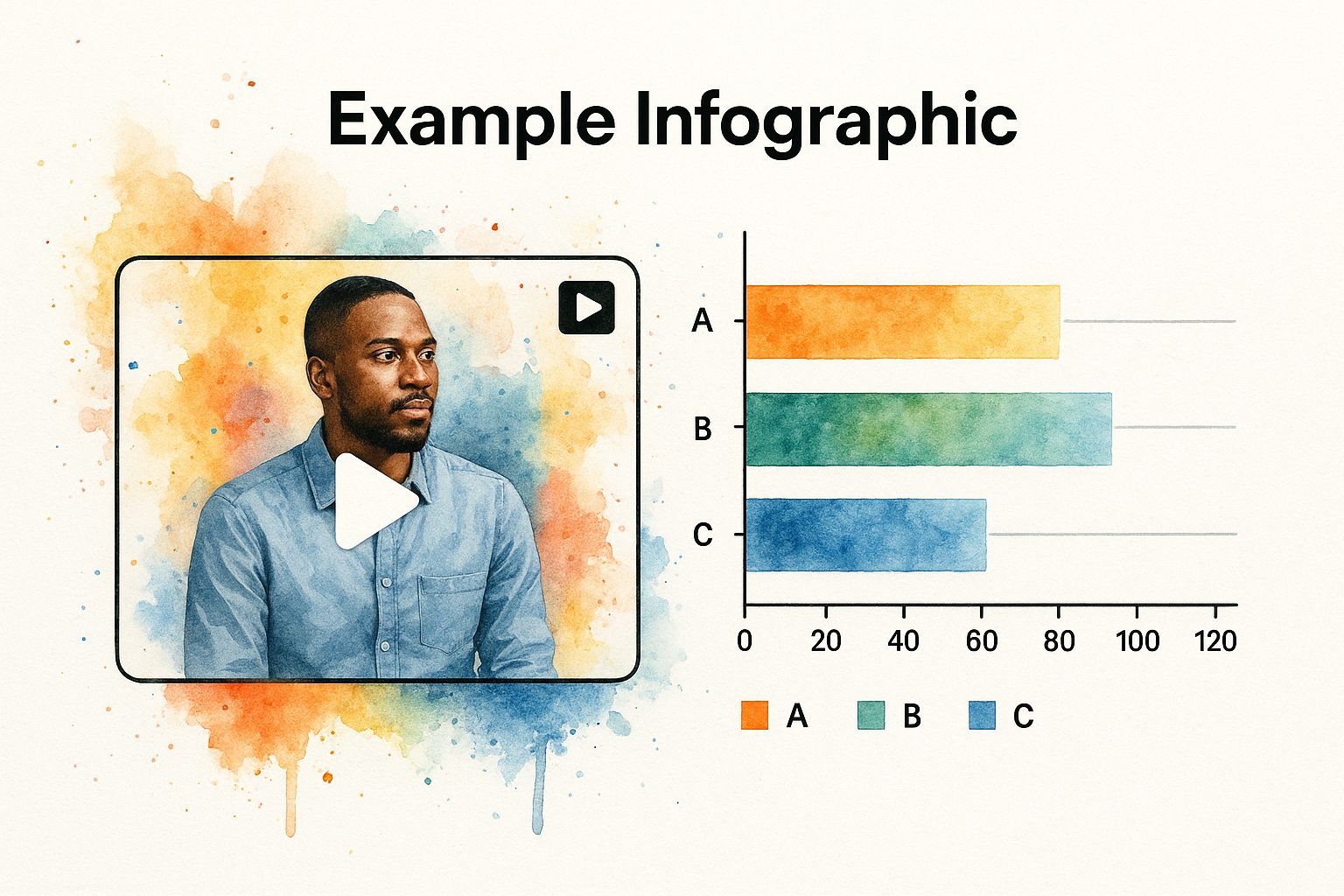In This Article
Subscribe to our newsletter
The Video Optimization Landscape: What Really Works Now

Creating compelling video content is only half the battle. Without a solid optimization strategy, your videos might get lost in the online shuffle. Think of it like this: you've built a fantastic car, but without fuel, it won't go anywhere. This section explores the key elements that drive video success in the current online environment.
Understanding Viewer Behavior and Platform Dynamics
Viewer behavior is constantly changing, impacting how we optimize videos. Different platforms cater to different audiences and content formats. A long-form tutorial might do well on YouTube, while shorter, engaging clips might perform better on TikTok. Understanding your target audience and the nuances of each platform is crucial.
There's a clear shift towards shorter, more digestible content. Short-form video has exploded in popularity. Platforms like TikTok, Instagram Reels, and YouTube Shorts have seen a 75% increase in global consumption.
This trend underscores the need for concise, high-impact videos. Marketers have a mere three seconds to capture viewer attention. By 2025, it's projected that 89% of businesses will use video as a marketing tool. The success of short-form video is evident in its ability to boost brand awareness, website traffic, and lead generation. For more insights into these trends, check out these video marketing statistics.
Focusing on ROI and Key Metrics
Not all optimization tactics are equal. Some deliver substantially higher returns than others. It's essential to focus on strategies that maximize ROI. Measuring the right metrics is also crucial. This data helps you understand what's working and what needs adjustment.
Prioritizing Optimization Efforts
Effective resource allocation is critical, especially with limited time and budgets. Prioritizing the most impactful optimization strategies ensures the best results.
This could involve keyword research, creating engaging thumbnails, or promoting your videos on the right platforms. By focusing on what truly makes a difference, you can make informed decisions and achieve your video marketing objectives.
Mobile-First Optimization: Capturing the Thumb-Stopping Moment

Today, mobile devices are the primary way people watch videos. This makes optimizing videos for mobile essential for connecting with your audience. Let's explore how to ensure your videos truly shine on smaller screens.
Aspect Ratios and Mobile Viewing
Choosing the correct aspect ratio is the first step. The traditional widescreen format is 16:9, but vertical videos (9:16 or 4:5) are now dominant on mobile platforms like TikTok and Instagram Reels. These vertical formats maximize screen space and provide a more immersive experience on phones. Imagine watching a widescreen movie on your phone; you'd see large black bars at the top and bottom. Vertical video solves this problem.
Structuring Content for Quick Engagement
Mobile viewers often have short attention spans. Grabbing their attention quickly is crucial. Start your videos with a compelling hook: a question, a surprising visual, or a quick shot of exciting action. Think of it as a movie trailer designed to grab interest in seconds.
The Power of Soundless Storytelling
Many people watch videos on mute, especially in public. A surprising 85% of mobile videos are watched without sound. This highlights the importance of visual storytelling. Use text overlays, engaging animations, and clear visuals to convey your message, even without audio. Captions are also essential for accessibility and engagement.
Optimizing videos for mobile is no longer a trend—it’s a necessity. 75% of video consumption happens on mobile platforms, reinforcing the importance of mobile-first viewing.
Adapting to Shorter Attention Spans
While short-form video is growing, longer videos can still be successful on mobile. The key is adapting your content to keep viewer attention. Break lengthy topics into smaller, digestible segments. Use visual cues, like transitions and animations, to maintain a dynamic pace. Structure your content to provide value quickly.
The Future of Mobile Video
Emerging technologies like 5G are changing how we consume video. Faster speeds mean higher resolution video and more interactive experiences. Consider how these changes might influence your video strategy. 70% of YouTube watch time is from mobile devices. As mobile video continues to grow, staying ahead of the curve is essential. For a deeper look at video marketing statistics, check out this resource: Video Marketing Statistics. With 5G expected to boost mobile video consumption by 30% by 2025, adapting to this mobile-centric landscape is key for reaching your audience effectively.
Technical Mastery: Resolution, Format, and Quality Balance

Optimizing your video's technical aspects is crucial for a positive viewer experience. It's about striking a balance: high-quality visuals combined with manageable file sizes for smooth playback. This balance is key to creating professional and engaging video content. Let's delve into the technical details that impact viewer experience and how to fine-tune your videos for optimal performance.
Exporting Videos: Platform-Specific Best Practices
Every platform has its own technical specifications. Exporting your videos with the correct settings ensures they look their best, whether it's on YouTube, TikTok, Instagram, Facebook, or any other platform. For instance, YouTube prefers MP4 format with the H.264 codec, while TikTok often benefits from more compressed formats due to its mobile-first user base. Understanding these nuances is essential for reaching a wider audience. For deeper insights into video optimization, check out this helpful resource: How to master video optimization for the web.
Codecs and Content Types: Choosing the Right Tools
Codecs are the backbone of video files, dictating how video data is compressed and played back. H.264 is a versatile codec offering a good balance of compression and compatibility. On the other hand, ProRes prioritizes quality, making it ideal for professional editing workflows. Choosing the right codec ensures your video files are optimized for both quality and delivery.
Optimizing File Size Without Sacrificing Quality
Large video files often lead to buffering, which can frustrate viewers. Fortunately, you can reduce file size without significantly impacting visual quality. Variable bitrate encoding (VBR) is a technique that intelligently allocates data based on the complexity of the scene. Simpler scenes use less data, resulting in smaller file sizes without a noticeable drop in quality.
Advanced Techniques: Variable Bitrate and Adaptive Streaming
VBR acts as a smart controller for your video data, efficiently managing file size. Adaptive streaming takes optimization a step further by adjusting video quality based on the viewer's internet connection. This dynamic approach ensures a smooth viewing experience regardless of internet speed.
Understanding Resolution Trends
Video resolution significantly influences viewer engagement. The following data chart visualizes resolution trends based on a recent Wistia study, showing how viewer expectations are evolving.

The data chart highlights the growing demand for higher resolution videos. The shift is apparent in the 51% increase in vertical HD uploads, especially for mobile viewing. While 1080p remains the standard, the 19% rise in 4K content shows a clear preference for high-quality visuals. The decline in 720p and square video emphasizes the need to prioritize higher resolutions to meet current audience expectations.
To understand these trends in greater detail, you can explore further statistics here.
The following table provides a comparison of recommended video resolutions for different platforms:
Video Resolution Comparison for Different Platforms
| Platform | Recommended Resolution | File Size Impact | Viewer Retention | Best Use Case |
|---|---|---|---|---|
| YouTube | 1080p (HD) | Moderate | High | General content, tutorials, vlogs |
| TikTok | 1080x1920 (Vertical HD) | Low | High | Short-form, mobile-first content |
| 1080x1920 (Vertical HD) | Low | Medium | Stories, Reels, short videos | |
| 1080p (HD) | Moderate | Medium | News feeds, longer videos | |
| Twitch | 1080p (HD) | High | High | Live streaming, gaming |
This table highlights the platform-specific resolution recommendations. Notice the emphasis on Vertical HD for mobile-centric platforms like TikTok and Instagram. While 1080p remains a strong choice for YouTube, Facebook, and Twitch, the file size impact varies.
By understanding resolution, codecs, and advanced techniques like VBR, you can ensure your videos are not only visually appealing but also technically optimized for success.
Search Engine Visibility: Getting Your Videos Discovered
Creating top-notch videos is only half the battle. If your audience can't find them, your efforts are wasted. That's why applying Search Engine Optimization (SEO) techniques to your videos is critical for increasing their visibility. Let's explore proven SEO strategies to help your videos get discovered.
Keyword Research and Implementation
Just like standard website SEO, keyword research is essential for video optimization. Successful video creators pinpoint video-specific keywords that resonate with their target audience. Tools like YouTube's search suggest feature and competitor analysis offer valuable keyword insights. For instance, a cake baking tutorial could target keywords like "how to bake a chocolate cake from scratch" or "easy chocolate cake recipe."
Optimizing Titles and Descriptions
Titles and descriptions are your video's first impression. They should be engaging and accurately summarize the content, naturally incorporating your chosen keywords. A strong title grabs attention, while a detailed description gives context and helps search engines understand your video's subject matter. Focus on providing genuine value, and avoid clickbait titles. For more tips, check out this article: How to master video SEO.
The Power of Thumbnails
Thumbnails are visual magnets that draw viewers in and boost your click-through rate (CTR). Create eye-catching thumbnails that accurately represent your video's content. Use vibrant colors, clear text, and engaging imagery to make your thumbnails pop in search results and suggested video sections. A high CTR tells search engines your video is relevant and interesting.
Technical SEO for Videos
Technical SEO is vital for video discoverability. Schema markup helps search engines grasp the context of your video, improving its chances of appearing in rich snippets. A video sitemap simplifies the crawling and indexing process for search engines. For those comfortable with advanced techniques, command-line tools like Ffmpeg offer fine-tuned control over video optimization.
Leveraging Transcriptions
Video transcriptions provide significant SEO advantages. Search engines can crawl the text within transcriptions, identifying relevant keywords and topics. This greatly improves your video's searchability. Transcriptions also make your content accessible to a wider audience, including viewers who are deaf or hard of hearing.
Platform-Specific Optimization
Each video platform has its own optimization quirks. YouTube prioritizes watch time, comments, and subscribers. TikTok relies heavily on hashtags and trending sounds. Instagram favors visually appealing content and engagement metrics such as likes and shares. Understanding these nuances is key to maximizing your visibility on each platform.
Engagement Engineering: The Science of Viewer Retention
Technical optimization is only half the battle. If viewers click away before your video ends, your efforts are wasted. This section explores strategies to keep viewers glued to their screens from start to finish. It's about understanding viewer psychology and structuring your content for maximum impact.
Crafting Irresistible Hooks: The First Few Seconds
The first few seconds of your video are critical. You need a hook that instantly grabs attention and makes viewers want more. This could be a thought-provoking question, a surprising statistic, or a visually compelling image. Think of it as a movie trailer designed to pique interest immediately. For example, starting a cooking video with the finished, mouth-watering dish before showing the preparation can entice viewers to learn how to create it.
Strategic Pattern Interrupts: Maintaining Momentum
Even with a great hook, viewers can lose interest if the content becomes monotonous. Pattern interrupts are strategic changes in pacing, visuals, or audio that re-engage the viewer. These can include transitions, animations, B-roll footage, or even a sudden change in music. A well-placed pattern interrupt can be like a plot twist, keeping the narrative exciting.
Narrative Structures: Telling A Compelling Story
Effective storytelling is crucial for long-form videos. Develop a clear narrative structure with a beginning, middle, and end. This gives your video purpose and direction, keeping viewers invested. Consider how popular YouTubers structure their videos, even for simple tasks like unboxing a product, with a clear narrative arc.
Analytics-Driven Restructuring: Addressing Drop-Off Points
Use analytics platforms like Google Analytics to pinpoint where viewers are abandoning your videos. This data provides valuable insights into which parts of your video are losing their attention. Once you identify these weak points, you can restructure your content, add pattern interrupts, or clarify confusing sections to improve viewer retention. For more in-depth strategies, check out this guide on video content marketing strategies.
The Psychology of Calls-To-Action: Inspiring Action
Effective calls-to-action go beyond simply asking viewers to "like and subscribe." They're about understanding viewer motivation and framing your requests in a way that resonates. Instead of a generic “subscribe,” try something like, "Join our community for exclusive tips and behind-the-scenes content."
Interactive Elements: Boosting Completion Rates
Interactive elements, like polls, quizzes, and clickable annotations, transform passive viewing into active participation. These features encourage viewers to stay engaged and are more likely to complete the video. They also provide valuable feedback and data about your audience.
To further illustrate how to effectively measure and improve viewer engagement, let's examine some key metrics across different video platforms.
The following table presents key engagement metrics to track and benchmark across different video platforms.
Video Engagement Metrics Across Platforms
| Platform | Key Metrics | Good Performance | Excellent Performance | Optimization Priority |
|---|---|---|---|---|
| YouTube | Watch time, Average view duration, Click-through rate (CTR), Comments, Shares | 50-70% average view duration, 5-10% CTR | 70%+ average view duration, 10%+ CTR | Focus on compelling content and effective CTAs |
| View count, Average watch time, Reactions, Shares, Comments | 30-second average watch time, 1-2% share rate | 60-second average watch time, 3%+ share rate | Optimize for mobile viewing and early engagement | |
| View count, Reach, Impressions, Saves, Shares | 10-20% reach, 2-3% save rate | 20%+ reach, 4%+ save rate | Create visually appealing content and use relevant hashtags | |
| TikTok | View count, Average watch time, Shares, Comments, Likes | 50-70% average watch time, 2-3% share rate | 70%+ average watch time, 4%+ share rate | Optimize for short-form, engaging content and trending sounds |
This table highlights the platform-specific metrics that are most valuable for assessing and improving viewer engagement. While the specific numbers for "good" and "excellent" performance can vary based on industry and content type, the table provides a general benchmark. By focusing on the optimization priorities listed, creators can improve their video performance and reach a wider audience.
By mastering these engagement techniques, you can dramatically improve viewer retention and maximize the impact of your optimized videos. This focus on viewer engagement is a crucial part of optimizing videos effectively for any platform.
Strategic Distribution: Amplifying Reach Beyond Algorithms
Creating engaging content and optimizing it for search engines is a great start. However, even with flawless SEO, your videos need a solid distribution strategy to truly flourish. Many creators overlook this crucial step, relying solely on platform algorithms. It's like writing a book and just leaving it on a shelf – you need to actively get it in front of readers.
Multi-Channel Approach: Expanding Your Video's Footprint
A multi-channel distribution strategy is essential for maximizing visibility. This means sharing your videos across various platforms, not just their original home. A YouTube tutorial, for example, could also find an audience on Facebook, Twitter, and relevant online forums.
Repurposing Content: Getting More From Your Videos
Repurposing content is another powerful technique. Adapt your videos for different platforms and formats without recreating them from the ground up. A long-form YouTube video can become a series of short clips for TikTok or Instagram Reels. You could even extract the audio for a podcast episode. This expands your reach and maximizes the value of your existing work.
Timing Your Releases: Catching Your Audience at the Right Moment
Strategic timing plays a significant role in video performance. Consider when your target audience is most active online. Posting educational content during weekdays, for instance, might yield better results than weekends.
Leveraging Your Existing Network: Connecting Directly With Your Audience
Don't forget your current audience! Announce new videos via your email list and engage with your online communities. This direct connection generates excitement and encourages early views, which can give your video an algorithmic boost.
Strategic Partnerships: Reaching New Viewers Through Collaboration
Collaborating with other creators or businesses in your niche expands your reach to new audiences. Consider guest appearances, co-created content, or simply cross-promoting each other's work.
Measuring the ROI of Distribution Channels: Focusing on What Works
Not all distribution channels perform equally. Track your results to identify which platforms deliver the highest return on investment (ROI) for your content. This data-driven approach ensures you're focusing your energy on the most effective channels.
By implementing these strategic distribution techniques, you can go beyond algorithm-driven platforms. This approach drives audience growth and maximizes the impact of your video optimization efforts.
Ready to improve your video creation process and expand your reach? Aeon is a powerful video creation platform designed for publishers. Learn more about how Aeon can help you create engaging video content at scale.






.jpg)